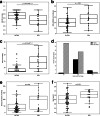Predicting future fallers in Parkinson's disease using kinematic data over a period of 5 years
- PMID: 39638907
- PMCID: PMC11621420
- DOI: 10.1038/s41746-024-01311-5
Predicting future fallers in Parkinson's disease using kinematic data over a period of 5 years
Abstract
Parkinson's disease (PD) increases fall risk, leading to injuries and reduced quality of life. Accurate fall risk assessment is crucial for effective care planning. Traditional assessments are subjective and time-consuming, while recent assessment methods based on wearable sensors have been limited to 1-year follow-ups. This study investigated whether a short sensor-based assessment could predict falls over up to 5 years. Data from 104 people with PD without prior falls were collected using six wearable sensors during a 2-min walk and a 30-s postural sway task. Five machine learning classifiers analysed the data. The Random Forest classifier performed best, achieving 78% accuracy (AUC = 0.85) at 60 months. Most models showed excellent performance at 24 months (AUC > 0.90, accuracy 84-92%). Walking and postural variability measures were key predictors. Adding clinicodemographic data, particularly age, improved model performance. Wearable sensors combined with machine learning can effectively predict fall risk, enhancing PD management and prevention strategies.
© 2024. The Author(s).
Conflict of interest statement
Competing interests: J.J.F. and C.A.A. were supported by the National Institute for Health and Care Research (NIHR) Oxford Biomedical Research Centre (BRC) J.J.F. has received consulting fees from Abbott and Medtronic, unrelated to this study. J.J.F. and C.A.A. have received research grant support from UCB Pharma. The remaining authors declare no competing interests.
Figures




References
-
- Fasano, A., Canning, C. G., Hausdorff, J. M., Lord, S. & Rochester, L. Falls in Parkinson’s disease: a complex and evolving picture. Mov. Disord.32, 1524–1536 (2017). - PubMed
-
- Grimbergen, Y. A. M., Munneke, M. & Bloem, B. R. Falls in Parkinson’s disease. Curr. Opin. Neurol.17, 405–415 (2004). - PubMed
-
- Crouse, J. J., Phillips, J. R., Jahanshahi, M. & Moustafa, A. A. Postural instability and falls in Parkinson’s disease. Rev. Neurosci.27, 549–555 (2016). - PubMed
-
- Thurman, D. J., Stevens, J. A. & Rao, J. K. Quality Standards Subcommittee of the American Academy of Neurology Practice parameter: assessing patients in a neurology practice for risk of falls (an evidence-based review): report of the Quality Standards Subcommittee of the American Academy of Neurology. Neurology70, 473–479 (2008). - PubMed
LinkOut - more resources
Full Text Sources

